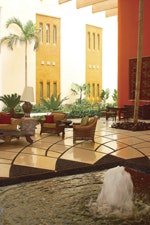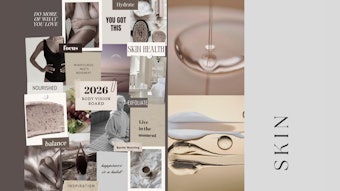
It isn’t easy to impress the average spa client. She’s not new to five-star service, custom treatments or tasty low-cal fare, and when she books a spa vacation twice a year, she wants something more. The destination should cater to her goals and unique interests, and should feel as though it were built just for her. With the recent trends in spa design, finding this is as painless as a good pedicure.
To compete in an ever-expanding market, spas are defining and refining themselves to mirror the desires of their clientele—and they’re starting from the ground up. Here’s how spa designers are helping owners find their fingerprint. For more ideas, see Tips and Trends.
Location
Before creating blueprints, Michael Effler flies to a proposed spa location to determine the spirit of the land. “It’s a matter of
| Tips and Trends Following are some additional ideas to keep in mind when conceptualizing or redesigning your spa. Break out of boxes. “We’re looking at changing the dynamic of the medical industry by getting physicians out of boxes,” Effler says. He recommends creating client-friendly spaces by redesigning areas where medical procedures are performed. According to Effler, “No one likes sitting on those little paper things.” Foster a sense of community. “We’re beginning to realize the wisdom of our Asian and European counterparts,” Segerberg says. “Along with private spaces, we’re creating areas for women and men to relax together.” Include men and younger clients. According to information compiled by the International SPA Association (ISPA), in 2003, men accounted for 29% of spa clientele—an increase of 5% from the previous year. Those males between the ages of 16 and 24 made up 14% of spa business. Segerberg recommends keeping these statistics in mind when creating treatment menus. Customize longer treatments. “The last few menus we’ve created include some nice long treatments. People are beginning to realize if they spend more time, they receive longer-lasting, more profound results,” says Segerberg. |
Effler says that in 23 years of business he’s never duplicated a design. “Originality is the most powerful tool we bring to the table,” he says. For the Salon & Spa at Ocean Reef Club in Key

To stay competitive, the spa may remodel next year, but manager April Smith says elements of Effler’s original design—such as water features and tropical plants—will be retained to keep the emphasis on the spa’s locale. “That’s the No. 1 reason why people come down here,” she says. “They’re escaping the cold climates of New York and Chicago to relax.”
For the outdoor enthusiast, Spa Prunifolia at Callaway Gardens in Pine Mountain, Georgia, creates a natural spa experience with homegrown homeopathies. Situated on 13,000 acres of woodland preserve, clients enjoy treatments that utilize fruits, flowers and herbs from the spa’s own organic garden. After services, clients can take a stroll through the resort’s butterfly conservatory or rent a boat for bass fishing on Mountain Creek Lake.
“We had to create a personality for that spa that was very natural,” says Jane Segerberg, vice president of JGL, Inc. Spa Design and Consulting. “The materials used give the spa an organic feel.” Exposed beams and furniture showcase oak wood native to the area. Cement and steel accents create a somewhat unfinished appearance, while natural colors such as jade, muted gold and brown bring the outdoors inside.
Sustainability
Seeking locations that are just as healthy as themselves, spa clients are going to green spas, says Gregori
The facility, set for completion in 2009, will use locally produced and recycled materials to meet the U.S. Green Building Council’s Leadership in Energy and Environmental Design (LEED) Gold Certification. Water—the surrounding desert’s most cherished resource—is respected by recapturing that which is used on site to nourish the spa’s grounds. Cotton batt insulation will cover Sailing Hawks’ roof and walls to create an energy-saving shell, while diminishing disturbing outdoor glares. Autoclaved aerated concrete (AAC), an environmentally friendly construction material, will be used in the building process. AAC emits no pollutants, and creates no by-products or toxic waste.
An environmental focus does not translate to less attention to client needs, Moran says, noting that a sustainable design is readily achievable by most spas. “We love trying to incorporate these elements at other spas because they’re so easy,” she says. “Some spa owners have this preconceived notion that it’s going to cost them an arm and a leg, but that’s just not so.”
Culture
Highlighting your spa’s location or sustainable practices isn’t the only way to help it stand out. Clients may also be drawn to the promise of a cultural escape. Skaná, the spa at Turning Stone Resort & Casino in Verona, New York, emphasizes the customs of the native Oneida Indian Nation. Here, therapeutic treatments focus on bringing harmony to the mind, body and spirit.
“Yohutsya: te:” which translates to “from the earth,” is an 80-minute wrap based on the ritual of using medicinal mud in healing. Segerberg and her crew spent six months researching the tribe’s traditions of healing and herbal practices to bring the facility to life. “They are very hospitable people,” she says. “In their language, the word ‘welcome’ means ‘you’re invited.’ We wanted the spa to have this feel.”
Because the Oneidas lived in communal longhouses, Segerberg included a large conversational place where clients can connect and shed life’s worries. The setting replicates an outdoor camp setting with decorative unfinished wood logs and leather tufted rugs, crafted to replicate fallen leaves, around a real fire pit.
“When you’re talking about spa clients, most of them are upwardly mobile,” Effler says. “They have taken that ultimate cruise and experienced some of the best hotels abroad. To make sure they’re going to be appeased, you have to go beyond.”
At the Avanti Spas in Tacoma, Washington, this is exactly what Effler does. Here, patrons enter a European village in an indoor courtyard. The reception area is illuminated by lights that hang from an 18-foot ceiling where water features and cobblestones recall Paris or Portofino, Italy. IDC created special design surprises—such as decorating the exteriors of each of the 12 spa treatment rooms like individual storefronts—in order to keep clients intrigued. Interiors are decorated with rich mahogany woods, and butterscotch, terra-cotta and clay tones. To ensure a competitive edge, Effler recommended that Avanti includes minimally invasive medical treatments, such as microdermabrasion and photorejuvenation. “You’re really not trying to copy anyone anymore. You’re trying to stand apart,” he explains. “You’re working hard to become an original piece of art.”










